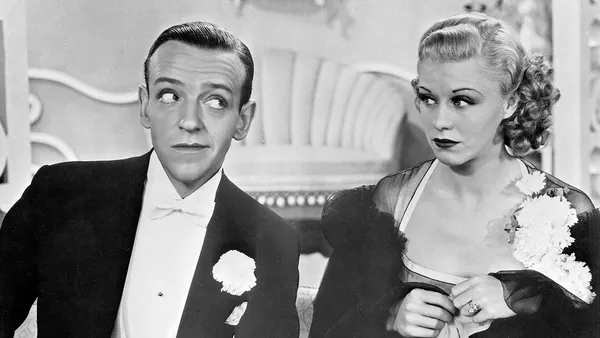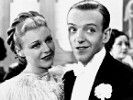Eye For Film >> Movies >> Top Hat (1935) Film Review
Top Hat
Reviewed by: Chris

Entertainment is often about vicarious experience. We see someone falling in love. We see them having fun. Or being daring – executing something impossibly brilliant – and we share those emotions. Seeing Fred and Ginger dancing ‘Cheek To Cheek’ is one of the definitive images of elegance from the 20th Century. It creates a 'movie magic' to bring shivers to the spine and tears to the eyes. We see him successfully woo a beautiful but lovable woman, in impossible circumstances and in very beautiful surroundings. It appeals to our sense of achieving a dream. We ‘suspend disbelief’ in the ridiculous storyline, the fact that not only are they not really in love but that such standards of dancing require hard, painful work rather than effortless ease – we get the fairground whirl without paying the coin – at least beyond the price of cinema admission.
Like many romantic comedies of the day, Top Hat relies on mistaken identities. Showman Jerry Travers (Astaire) is working for producer Horace Hardwick in London. He is showing off his new dance steps late at night in Hardwick's hotel. The noise upsets the sleeping Dale Tremont (Ginger Rogers) in the room below. She goes upstairs to complain and the two are immediately attracted. Complications set in when Dale mistakes Jerry for her best friend’s husband. Romantic sparring continues through a sumptuous backdrop of wealthy Venice. Ginger sheds tears, as well as shedding feathers from one of the most beautiful screen gowns ever devised (and probably the most famous in movie history). Astaire is threatened with the sword by an Italian dress designer (Beddini) who is determined to marry Dale.

Fred & Ginger are the most famously enduring of any dance couple. Their style still inspires long-running TV shows like Strictly Come Dancing and Dancing With The Stars. Of ballroom dances, the American Smooth is said to pay particular tribute to Fred Astaire. Top Hat is the most iconic, most popular, most lavish and undeniably the most beautiful production featuring their dancing. It will be remembered, revered and enjoyed for many years to come.
This movie, along with most of this dance pair’s films, was released in the midst of the Great Depression, when cinemagoers wanted to escape the deprivations and daily grind by imagining such characters spending every moment in the lap of luxury, wearing evening dress. Cinemas allows audiences to dream, and dream they did. Hollywood benefited from the Wall Street Crash, as 60 to 80 million Americans would go to the movies once or twice a week. A nickel – the price of a gallon of petrol or a packet of cigarettes then – usually bought four hours of entertainment: a cartoon, a newsreel, a B-movie and the main film. But Top Hat was so successful that it was one of the few films able to dispense with the ‘double bill’ format. Only once in a 54-week run was it supported by any B-movie.
Shooting began on April 8, 1935 and finished on June 5, 1935. A canal was built at RKO studios, complete with floating gondolas and graceful bridges, rivalling the majesty of the Venice it depicted. The film cost $637,131 in total. A large amount went on sets and art direction. $20,138 went on wardrobe (Rogers’s changes of costume cost $3,025, and Astaire’s toupé $50). Songsmith Berlin was paid $75,000, Astaire $40,000, director Mark Sandrich received $36,250, and Rogers a mere $7,172. The film would break box office records, taking $350,000 in its first three weeks, and earning RKO a tidy $3,202,000 in rent and $1,132,550 over 54 weeks. RKO didn’t have the budget of industry leaders like MGM, Paramount, and Fox, but was strong on designers: many of their pictures contain a well-developed Art Deco element, as seen here in Top Hat.
Like Singin’ In The Rain, Top Hat is a movie milestone, beloved by fans. The best songs, superb dances, a crisp yet heart-warming ambience, lighter than Swing Time (which would follow it) and higher on production values than previous outings (such as The Gay Divorcee, which some felt it had copied). In the face of almost unparalleled greatness, it might seem churlish to take it to bits but, when so much time has passed, perhaps it is a testament to its excellence to also enjoy ‘looking under the bonnet’ – especially as such films do not appeal to everyone today the way they did in the 1930s.
Some of the subtexts in Top Hat are interesting to examine more closely. Inserting the ‘feelgood’ factor through celluloid at the height of the Depression happened on more than one level. Films like Top Hat reinforced it by stimulating pride in America, often at the expense of other countries. Foreign cultures might be ‘quaint’ or ‘exotic’ but only when seen through the US lens or absorbed into American cultural norms – and even then, usually in such a way that America triumphs over them. Astaire’s rivals are frequently humiliated foreigners – in this case the ridiculous Beddini (a characterization that so offended the government of Italy that the film was banned there.) Of secondary characters, Hardwick is the token stuffy Englishman (originally gay until the censors removed more overt references). The lack of substance to minor characters in Fred & Ginger films also generally adds to the sense that the main characters are the only ‘real’ ones, with whom we should identify.
The film appeals to our sense of elitism. As an accessory, a top hat is often associated with the upper class. As if we could forget: “I'm stepping out my dear to breathe an atmosphere that simply reeks with class.” Class dominance extends seamlessly to invest alpha-male portrayals of a character who is almost the opposite of rugged masculinity – Fred Astaire dances a solo in which he uses his stick as a pretend gun to shoot nameless male co-dancers of the chorus. Overt references to male dominance were toned down by the censor. A famous line, “For the woman, the kiss! For the man, the sword!” was originally, “For the man the sword, for the woman the whip!”
We can pursue this argument right into the dance itself, partner-dancing being a male-led dance. Normally in partner-dancing, it is the woman we admire. There is a saying, “The woman is the picture, the man is the picture frame.” If there is any couple that most reverses it, it is Fred and Ginger. Ginger, the far more experienced actor with many films under her belt, directs audience attention to Fred with every facial expression, whereas Mr Astaire struts his stuff like a peacock attracting the female. Gene Kelly ironically meant it as a compliment when he said, “When Ginger Rogers danced with Astaire, it was the only time in the movies when you looked at the man, not the woman.” (The only exception I can recall to this was when Astaire danced with Cyd Charisse, a long-legged, and very polished, ballet-trained dancer and actress.)
Finally we can question the double illusion of dance. Dance can be an expression of joy, a natural movement of the body, something learnt, a social skill that can empower and give confidence, or straightforward entertainment for others. The joy we experience watching Fred and Ginger, or even learning the dances ourselves, is of a strictly ephemeral nature, overlaid with the promise of lasting joy once marriage (on whatever flimsily created grounds) is assured, and all achieved with beautiful dresses and opulent surroundings. A faint reminder of the joy that a child experiences dancing for its love of life. Or the joy sustained by dancers driven by rhythmic carnival drumming (Imperatriz Do Carnaval). Or the journey of self-discovery through dance (The Tango Lesson). And it is far from the use of dance for religious joy in The Divine Horsemen. For a more ‘feminist’ approach to the tropes typically handled in traditionalist manner by Rogers’ films, we could favourably compare Dorothy Arzner’s work (Dance Girl, Dance, RKO 1940).
François Delsarte analysed the relationship between dance gesture and emotion: for instance, the way the back is arched, the chest expanded, suggests positive, expansive and joyous feelings. In partner-dance, such gestures are codified to convey an impression of joy even when it is absent, or manufactured, or indeed incidental. But even such an artificially created gesture can have a deep effect. Rogers’ character is convincingly won over by Astaire’s – ultimately she capitulates completely, in a deep backbend, surrounded by the angelically drifting ostrich feathers of her elaborate dress.
Reviewed on: 22 Feb 2011
















